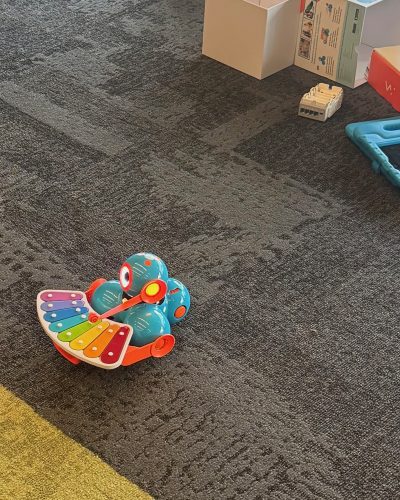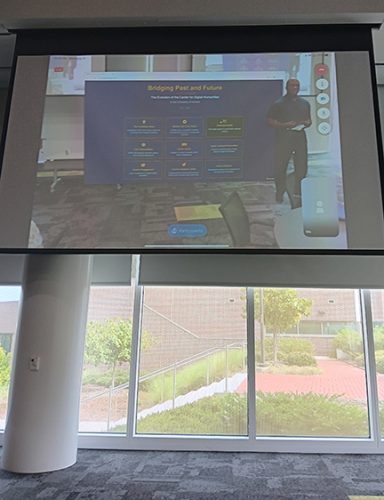Denice, Melde and I (Joddy) traveled to Hunt Library in Raleigh, NC on Aug 20 – 22 to attend the Library Technology Immersion Conference organized by ASERL and NC LIVE – a chance to learn about innovative technologies in libraries.
Denice Lewis
The ASERL Library Technology Immersion Conference always presents a diverse range of technologies utilized in libraries. From Dr. Bryan Carter presenting via a hologram to Gale’s products incorporating AI, it was interesting to see different technologies and methodologies. This year’s conference included attendees from public as well as special libraries in addition to academic libraries. The mornings were scheduled with everyone in attendance at the same presentations whereas 3-hour workshops covered the afternoons. By chance, my Thursday morning breakfast and learn presentation “Considering the possibilities with AI” wove in key points and people from Wednesday morning’s talks.
On Wednesday afternoon, I attended “AI-mazing Possibilities in Libraries: From Basics to Best Practices” facilitated by Delandrus Seales from UNC Wilmington. I had the opportunity to work with Feng-Ru Sheu from Kent State. I will raise my hand and confess that we tested different prompts using Gemini, ChatGPT, Groq, Mistral’s Le Chat, Perplexity.ai, and Claude.ai. We may have even into played with Adobe Firefly. Yes, all of the typical chatbots I use have changed in some way. For instance, Perplexity marketed a new browser, Comet. ChatGPT 5 showed that it had solved previous issues e.g. counting the number of r’s in strawberry and including links to actual articles. Initial tests of the first couple of links resulted in actual articles. The next test will determine if the articles are open access or paywalled articles.
On Thursday afternoon, I sat in on “Critical Play Generative AI” facilitated by Colin Keenan and Colin Nickels form NC State University. It was interesting to see their site instance of Midjourney which was integrated into a Discord server.
Although the two days were literally jam packed with information, I came away with ideas for my NCLA pre-workshop format and new features to experiment with.
Joddy Marchesoni
Wednesday (Day 1) – teaching AI
On the first day, I taught a workshop, “Accelerating Data Requests with Perplexity AI.” The goal of the workshop was to show librarians from any background how they can help with data requests using AI deep research tools. Perplexity is an AI deep research tool that’s great at finding data sources, but needs careful attention to use effectively. It responds to a prompt like a standard chatbot, but delves deeper into a variety of sources to make a detailed report on the topic including recommended data sources for a patron request.
Before we jumped in to start using the tools, attendees engaged with two zines on using AI: “AI IS VERY BAD, ACTUALLY: A MANIFESTO”, and “What shouldn’t AI be used for?” from the Intersectional AI Toolkit Workshop series. The goal was to start a conversation about how librarians should be using AI, and to stop and consider the ethical issues surrounding the technology before jumping into using it.
The attendees were librarians from a variety of institutions, including 4-year universities, community colleges, public libraries, and even federal archives – a diversity of perspectives. Throughout the workshop, the priority was to get folks thinking about how this tool could help them as well as its limitations.
Using the free tier of Perplexity, the group got hands-on practice using an AI tool to do research, evaluate sources, and consider how to use the research report in responding to a patron. We hit some of the tool’s limitations, including source reliability, consistency of results, and difficulty evaluating proprietary data sources. They were also concerned about privacy, like sharing a potentially identifying request with an AI that may train on the results. Overall, the group was excited to try the tool out, and I hope they continue experimenting with it in their work.
DISC is considering holding a shorter version of this workshop for ZSR employees, so please let us know if you’re interested!
Thursday (Day 2) – Robots!
On the second day, I went to a workshop called “Robots Welcome: Launching Sustainable Robotics Programs in Library Spaces” offered by a great presenter, Alan Hanstein. He works with the Challenger Learning Center, the outreach center for FSU’s College of Engineering, and primarily works with K-12 students. He presented us with 5 different types of robots he uses with students, ranging from the simple (Indi), to the complex (LEGO Mindstorms). The simpler ones are great for teaching basic problem solving skills, and for stress relief, while the complex ones are powerful tools for building coding and robotics skills. The goal of the workshop was to show how engaging robots can be, and how to design sustainable outreach programs with robots for college students.
The sustainable aspect of robots for outreach are:
- You can make a one-time purchase that will last through the life of the technology
- Anyone can teach a robot workshop or stress-relief session if they have good instructions, and
- The same robot can be used for a variety of activities (relaxation and stress relief during exam periods, a tool for teaching problem solving, or an engineering challenge)
The “simple” robots were the Indi and the Ozobot, which both use colored squares to control the movement of a car-like machine. Coding is putting down different squares of color and seeing if you can get the robot to reach its goal.
The in-between ones were the Sphero and Cubelets. Sphero is a sphere-shaped rolling robot with programmable LED lights, sound, and movement, controlled over Bluetooth with tablet software. The instructions for the bot are created through “block programming”, basically visually combining blocks on the tablet screen for the controls. These robots can be programmed for mini golf, mazes, or even playing a glockenspiel!

The Cubelets are magnetic cubes that fit together, and each cube performs a different mechanical function. Creating and programming these bots involves putting the cubes together in different configurations, moving the dials and levers on the cubes, and seeing what happens. These were my favorite ones since they were so tactile and intuitive, letting participants learn by doing without knowing how they work.
Lego Mindstorms robots are very flexible, and can be operated through block programming, or through full programming languages. Since they are made out of legos that can be assembled in a multitude of ways, the programmer can build a robot to accomplish a very specific task. I liked the combination of mechanics and programming that makes this one feel more like a full-fledged engineering tool.
Alan was an inspiring instructor, showing us how effective these devices are for outreach, while also giving us robots to experiment with! Activities included:
- Laying out colored squares for Indi to complete a course (it was so exciting for our group to complete our goal!)
- Getting the Ozobot to bowl using tiny bowling pins
- Painting with the Sphero (very abstract painting, “more Jackson Pollack than Leonardo da Vinci” as Alan said)
- Tinkering with the Cubelets to make a noisy, rolling contraption
Alicia LaPrelle, who serves as the Education Librarian, Outreach Coordinator, and AP Summer Institute Director here at Wake, was also in this workshop, and she was inspired to look into buying robots for next year’s outreach activities at the Education Library.
It was a lot of fun, and definitely inspired some outreach ideas for ZSR!
Breakfast and Learn with Denice
Last but not least, I went to Denice’s Breakfast and Learn on Thursday, and got some great ideas for new AI tools to experiment with. I have a feeling that I will be using these tools more often in my work, and her presentation included some intriguing possibilities. I also identified with her being a “4th career librarian”, as I’m a 3rd career librarian myself. Her approach and perspective were inspiring for me!
Behind the workshops and other scheduled activities, I had a lot of great conversations about how AI is impacting libraries, and how we should adapt to it. And I also got a chance to consider other emerging technologies and the value of investing in high-tech tools. It was a fun and valuable experience, and I’ll definitely make another workshop proposal for LTIC next year!
Melde Rutledge
The start of the conference began for me with the keynote on Day 1 presented via hologram by Dr. Bryan Carter. Carter is the founder and director of the Center for Digital Humanities and a professor in Africana Studies at the University of Arizona.
The center aims to positively impact communities of color and provide students with hands-on experience with advanced technologies. Volumetric video capture is the Center’s core technology. Since its founding in 2017, the Center has secured over $5 million in grants and has 18 developers.
“When I saw this technology, I knew that it would be beyond simple immersion, because not many people want to walk around with a big old headset on their face,” he said.
Utilizing volumetric video capture, Carter spoke to the audience while being displayed on the projection screen via a hologram. The projection screen incorporated the view of our meeting room with Carter integrated into video via a 3d hologram.

Carter highlighted the Center’s use of volumetric video capture, which is still a cutting-edge form of holographic technology that records people and objects in three dimensions without relying solely on VR headsets. The Center’s current initiatives include digital scanning of historic sites along Route 66 and recording Holocaust survivors using volumetric video capture. The center is also working with historically black colleges and universities on a Smithsonian exhibit opening in November. Students from multiple disciplines are at the heart of these initiatives.
“Through these technologies, we’re able to tell stories differently, preserve culture very differently, and relate ideas about communities very differently,” he explained.
Carter also noted that the future of digital humanities lies in combining technology with cultural storytelling, and emphasized that digital humanities is not about siloed research but about expanding access and impact.
Workshops
It’s safe to say that the use of artificial intelligence in the workplace will eventually be our new normal, and for some of us, that’s already the case. It seemed appropriate to me that a notable portion of the conversation at the conference covered this technology.
The AI centered workshops also seemed to be the most popular sessions to attend at the conference. When registering for the event, attendants had to sign up for the two workshops we were allowed to attend. These seemed to fill up fast, but I did have the opportunity to sign up for one of them:
Accelerating Data Requests with Perplexity AI
Starting with the workshop I attended on Day 1, which featured our very own Joddy Marchesoni, I delved into how librarians can use Perplexity AI to solve and/or speed up tricky data requests. ChatGPT has been my go to generative AI tool, so this was a new realm for me.
We began the workshop by reading two zines covering the ethics of AI, and jotted down our thoughts on Padlet. The two zines raised strong critiques of AI, focusing on issues like environmental costs, surveillance concerns and lack of consent.
The reactions to the zines were mixed. Some found them one-sided. Others emphasized that while they shared the concerns, they believed librarians and educators should still engage with AI critically rather than avoid it, since students and patrons are already encountering and using these tools.
I felt that grounding the workshop in this discussion was a great starting point before we dove into the exercises, which featured a walkthrough of a real world data request actually Joddy received from a faculty member for Indian infrastructure data. Specifically, they requested data at the PINCODE level (similar to U.S. ZIP codes), and needed historical statistics on internet access, transportation, and socioeconomic indicators from 2014–2015.
We used Perplexity’s Deep Research mode, and began by pasting the request and also breaking it into keywords. I liked how it provided a summary table that ranked the sources by reliability and accessibility, which made it easier to judge whether data was public, restricted, or proprietary. While some of the sources Perplexity provided were credible, others required closer scrutiny. This reinforced the fact that librarians still need to vet the results.
One participant compared Perplexity to Wikipedia, meaning that it serves as a great tool to lead you to credible sources.
Another participant summarized, “At a minimum, these tools help me find background information and context about data requests. They won’t replace librarians, but they can accelerate how we start the search.”
We were also tasked with other data questions ranging from local demographics in Winston-Salem to business datasets such as flight records.
My takeaway from Joddy’s workshop using Perplexity is that this is an awesome tool for research, but not to be used as a standalone. Accuracy, source diversity, and transparency remain big concerns. Also, being upfront with patrons about using AI in fulfilling their research requests does matter.
“AI is not always the answer”
This is a quote said by Talia Richards-Resendes, from Springshare, during her lunch and learn talk on Day 2. It was entitled, “The Hidden Engine of UX: Why the Right Tool Still Beats the Smart Tool.
AI may be everywhere in library conversations nowadays, but the real wins come from technology that’s simple, seamless, and human-centered, she explained. The technology has much promise, but it still doesn’t solve the real pain points library patrons face. This is my overall takeaway from her presentation.
Talia emphasized the importance of human-centered technology in libraries, and advocated for well-designed, reliable systems over AI overlay. What truly matters for libraries, she stressed, is designing technology that is seamless, reliable, and human-scaled.
She said rather than chasing flashy features, the focus should be on “invisible tech” that quietly supports the user experience. Several Springshare tools were highlighted as examples.
Talia noted that a student who feels lost in a sea of databases benefits far more from a contextual LibGuide or a quick chat with a human expert than from another AI-generated list of sources.
She also mentioned that case studies showed how frustration from students often stems from confusing logins, hidden booking forms, or poor signage, and not a lack of AI features. Having well-placed tools like LibGuides pop-ups, live chat integrations, personalized portals, and interactive maps can quietly reduce friction and keep librarians at the center of support, she added.
The Future of Library Service Integration
On Day 2, I attended the “Empowering Libraries, Engaging Patrons: The Vega Library Experience Vision” workshop by Michael Monroy, which was more so a demonstration of their suite of tools. The session also included questions he asked the audience throughout the presentation to understand the audience, uncover our pain points, and ultimately validate Vega’s features.
He began by asking attendees to introduce themselves by sharing their first name, the library they represent, and their role.
Using a live poll, he also asked:
“What patron engagement tool does your library use today?”
“Are any of you doing the integration yourselves, or is someone else at your institution managing that?”
“What solution does your library use for managing events, rooms, and equipment booking?”
A common challenge, he noted, is that “library staff… were spending their time integrating all these wonderful resources and tools, but having to spend a lot of time making sure they’re integrated.” Staff often lose valuable time maintaining system integrations instead of focusing on serving patrons, he explained.
The integrated modules in the Vega suite included discovery, mobile apps, chat, web building, events/room booking, and email marketing. Remote room unlocking, mobile self-checkout, and push notifications for holds and events were also highlighted.
As Monroy put it, “the market told us we would like our ILS vendor to give us the choice to have everything from one place.”
Overall, I believe the conference highlighted the balance libraries must strike between embracing innovation and staying grounded in user needs. Also, real impact depends on how well these technologies serve people.



10 Comments on ‘Denice, Joddy, and Melde at ASERL Library Technology Immersion Conference’
This sounds like a wonderful conference (especially the session on robots)! Thank you for sharing! Also, offering a workshop on how to use Perplexity would be awesome!
Jam packed indeed! So much to think about! Thanks for digesting this conference for us.
And yes, any ZSR workshops on these topics is welcome. Thanks!
Wow! It sounds like you all got a lot out of this experience! And any training that we can get on AI tools like Perplexity would be welcome!
Thank you so much for using my zine (“AI is very bad, actually: A manifesto”)! I hope it was helpful!
Thanks so much for keeping up with these technologies for us and bringing this info back to us all. Yes, please on the AI workshop for ZSR!!
Thank you for sharing a summary and your thoughts for several excellent sessions. I’m adding my voice in the chorus – yes to the AI workshop!
I learned so much from Joddy’s presentation, and today I presented to my department on how we can incorporate Deep Research into our data finding. It wowed everyone on the call!
Thanks for the feedback, Elizabeth! That’s awesome!
Julie, thank you for creating it! It was super helpful for getting an AI ethics conversation going 🙂
And to all the ZSR folks who want a Perplexity AI workshop, I hear you! If we decide to do AI workshops at the library, I’ll be ready to adapt the material